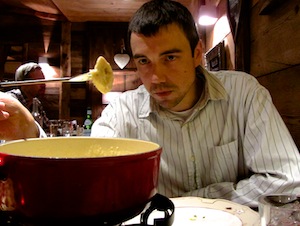When Eric and I visited the French and Swiss Alps a few weeks ago, a friend told us to try the Raclette and Fondue in both countries because of the regional differences in preparation. This was good advice for the Fondue, but I didn’t notice much difference when it came to the Raclette.
Raclette is a dish where a hunk of cheese is melted by a heat source and then the melted part is scraped onto boiled potatoes and dried meats, accompanied by pickled pearl onions and gherkins. For the best experience, you have to eat fast once you scrape the cheese onto your plate, because the cheese hardens again after a minute or two.
Raclette is a fun meal to share with others, and the cheese is tasty. It is a simple meal in terms of ingredients, but it does require special equipment to melt the cheese. I wonder if it is not better in a home setting though. Since we only had it at restaurants during our trip, our vegetable selection was limited to the potatoes, pickled onions, and gherkins. You could easily have a more interesting spread of vegetables at home.
When we had Raclette in France, we were served half a wheel of cheese. Needless to say we did not come close to finishing it. In Switzerland, however, we were only served a block, probably around half a kilogram or one pound of cheese, which we finished. The amount and the style of heating device were the only real differences we noticed between France and Switzerland.


The Fondue was delectable in both France and Switzerland, but there were some differences. Since there is a variety of regional cheeses in this part of the world, the cheese used in the Fondue naturally changes from place to place. In France we had Fondue savoyarde with Comté and Beaufort. In Switzerland we had “moitié-moitié,” or half Gruyère and half Vacherin Fribourgeois. The Swiss one tasted the closest to what I expect traditional Fondue to taste like, but they were both deliciously cheesy. I think the French one had more white wine in it, or perhaps omitted the classic Kirschwasser in the recipe.
As with the Raclette, I think you could have more interesting Fondue dinners at home by picking out your own veggies and sides. In the restaurants our choices were limited to bread and potatoes. To me, this got a little boring before the meal was half-way finished. Overall it was still an experience to eat Fondue in the Alps, and it would be interesting to try even more cheese combinations in the future.
For now we are back to eating cheese the normal way — on a baguette — but another Alpine cheese specialty we may try this winter is a baked hot box of Mont d’Or (Mont d’Or au four ou boîte chaude)! I’ll report back on how that is another day.
 Fromage
Fromage